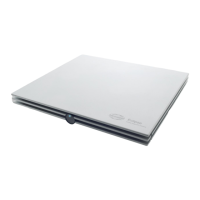Eclipse Additional Information Page 50
If a very tough rejection level is set: In this case, all noisy sweeps are simply rejected for both Bayesian and
non-Bayesian recordings. Only the most quite sweeps are accepted, and you have a situation almost similar
to above. With softer rejection criteria (e.g. 80µV) you would benefit from the contributions of the more noisy
sweeps in your averaging thus arriving at your desired residual noise level in less time.
If you run long enough to get a low residual noise level:
If two waveforms each have 40nV residual noise, then they will look equally clean. It does not matter
whether you have used 1.000 or 10.000 sweeps to get there or what type of weighting is used. Weighting will
simply get you there faster if the patient has fluctuating EEG during the session. It should be noted, that two
waveforms each with 40nV residual noise may exhibit minor variations in wave morphology, due to e.g. the
frequency distribution of the residual noise. This may differ with different test situations, and quite patients
tend to provide residual noise with more high frequency content and less low frequency content, which may
look nicer to the eye. So keeping the patient as relaxed as possible is still recommended.
Minimize Interference
When enabled, the system will insert random pauses between the stimuli in the order of a few milliseconds
depending on the rate of stimulation. When adding random stimuli pauses, the recording system will be less
sensitive to periodic electrical interferences as it should minimize the synchronization with the recordings. It
should minimize periodic interference which may, on screen, have a sine wave’s appearance. This approach
is an alternative to the use of a notch filter which carries the disadvantage of phase distortion of the re-
sponse.
These pauses will not influence the latency times or in any other manner, change the behaviour of ABR re-
sponses. Minimize interference is a useful feature to improve recordings made under periodic interferences
such as mains power interference.
3.7.1.11 Wave Reproducibility (Wave repro)
The wave reproducibility monitors the quality of the curve being recorded. Subsequently, when a predefined
quality (Wave repro level) is met, the user can decide to stop the testing and proceed to the next intensity.
The percentage refers to the calculated correlation between the two curves stored in the A buffer and the B
buffer. Even though these two curves are obtained during the same test run, they are actually separately ac-
quired - and therefore independent - data. It is for this reason they may be considered capable of depicting
test reproducibility. Please note that if the polarity of the stimulation is set to alternating, slightly less Wave
reproducibility may be encountered, as the A buffer will hold all the rarefaction data, and the B buffer will hold
all the condensation data resulting in curves which, by nature, will show slightly different characteristics.
The time window you wish to use for the correlation calculation is set by “Wave repro from” and the “Wave
repro to” bars. For neurologic testing a window from 4ms to 8ms will often prove useful. For hearing thresh-
old/screening testing, a slightly later window may be more appropriate.
3.7.1.12 Research availability (only with research licence)
Logging the data for the research module can be enabled and disabled for each protocol from here, and the
destination for the logged data can be changed.
3.7.1.13 Special tests
MMN/P300
This is where you assign how large a percentage of the stimuli for MMN testing shall be of the frequent stim-
ulus type. The rare rate is always 100 minus the frequent rate. Please refer to the description of the Protocol
settings for MMN and the Protocol settings for P300 for more information about the protocols settings for
MMN and P300.
VEMP
This is where you can change the parameters for the VEMP settings. Please refer to the chapter about the
VEMP module for a detailed description of the protocol settings for the VEMP protocols.

